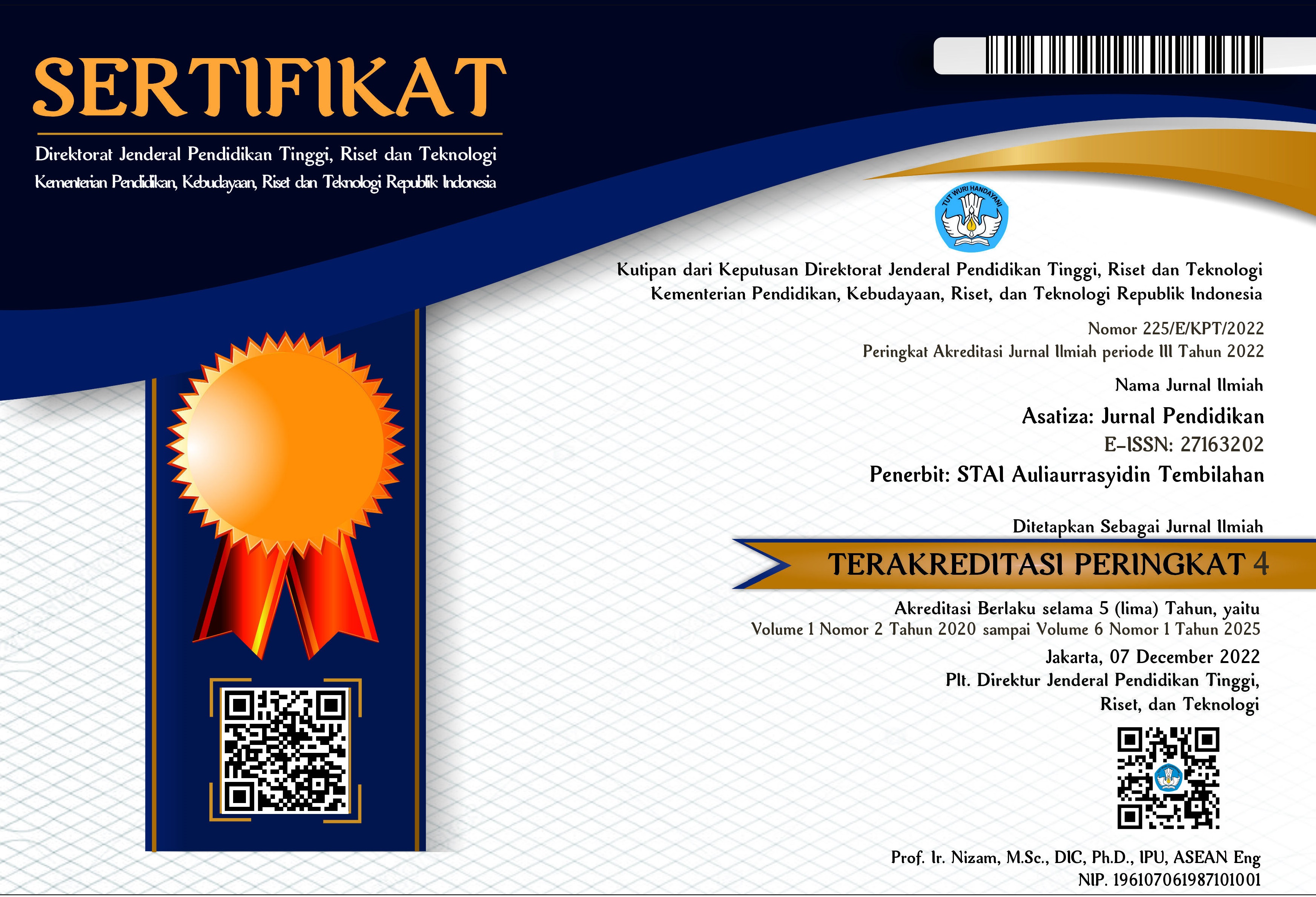Teachers’ Challenges in Teaching English for Young Learners during Indonesia’s School-Based Curriculum
DOI:
https://doi.org/10.46963/asatiza.v3i3.898Keywords:
Challenges, Teachers, Young Learners, KTSPAbstract
The goal of this study is to discover the challenges that teachers suffered from when teaching English to young learners in Tembilahan Elementary Schools during the School Based Curriculum in 2018. The quantitative descriptive design was used for this study. Researchers employed questionnaires and interviews as research tools to collect study results, the questionnaire functioning as the primary instrument. Questionnaires and interviews were distributed to ten teachers from nine different primary schools. The findings of the Likert questionnaire data analysis and interviews showed that the most difficult challenges for teachers in teaching English to young learners was learners’ motivation. They all believe that raising motivation was tough, and that was one of the difficulties in teaching English to young learners. The findings of the highest score in the data was the thirteenth statement (motivation), where the total score was 40, and it was a teaches’ challenges in teaching English to young learners in primary schools in Tembilahan.
Downloads
References
Andrade, C. (2021). The inconvenient truth about convenience and purposive samples. Indian Journal of Psychological Medicine, 43(1), 86-88. https://doi.org/10.1177/0253717620977000
Arikunto, S. (2010). Prosedur Penelitian: Suatu Pendekatan Praktek (Edisi Revisi 2010). Yogyakarta: Rineka Cipta.
Brewster, J., Ellis, G. and Girard, D. (2003). The Primary English Teacher’s Guide. New York: Pearson Education Limited.
Brown, H. D. (2001). Principles of Language Learning and Teaching. Beijing: Foreign Language Teaching and Research Press.
Cameron, L. (2001). Teaching Languages to Young Learners. Cambridge: Cambridge University Press.
Creswell, J. (2005). Educational Research (Planning, Conducting, Evaluating, Qualitative and Quantitative Research). New York: Pearson Education International.
Gay, L. R., and Airasian, P. (2000). Educational Research; Competencies for Analysis and Application. New Jersey: Prentice-Hall.
Harmer, J. (2007). The Practice of English Language Teaching. Harlow: Pearson Education Ltd.
Lesia, E. S., Petrus, I., & Eryansyah, E. (2022). Teaching English for Young Learners in Elementary School: Perceptions and Strategies. International Journal of Elementary Education, 6(1), 142–148. https://doi.org/10.23887/ijee.v6i1.42013
Miles, M. B., & Huberman, A. M. (1994). Qualitative data analysis: An expanded sourcebook (2nd ed.). Thousand Oaks, CA: Sage Publications.
Ministry of National Education. (2006). KTSP for English to Elementary Level. Jakarta: Depdiknas.
Nunan, D., & Bailey, M. K. (2009). Exploring Second Language Classroom Research. New York: Heinle.
Nur, C. (2003). English Language Teaching in Indonesia: Changing Policies and Practical Constraints. In W. K. Ho& R. Y. L. Wong (Eds.), English language teaching in east Asia today: Changing policies and practices. Singapore: Eastern Universities Press.
Pinter, A. (2011). Children Learning Second Languages. London: Palgrave Macmillan.
Riduwan. (2013). Skala Pengukuran variabel-variabel Penelitian. Alfabeta: Bandung.
Scott, W. A., & Ytreberg, L. H. (1990). Teaching English to Children. New York: Longman Inc.
Utama, A. H. (2021). The implementation curriculum 2013 (K-13) in teacher's ability to develop learning media at distance learning. Indonesian Journal of Instructional Media and Model, 3(2), 56-65. http://dx.doi.org/10.32585/ijimm.v3i2.1705
Downloads
Published
Issue
Section
License
Copyright (c) 2022 M. Ridhwan, Melda Yeni, Ana Imroatul Husna

This work is licensed under a Creative Commons Attribution-ShareAlike 4.0 International License.
Authors who publish with this journal agree to the following terms:
1. Copyright on any article is retained by the author(s).
2. The author grants the journal, right of first publication with the work simultaneously licensed under a Creative Commons Attribution shareAlike 4.0 International License that allows others to share the work with an acknowledgment of the work’s authorship and initial publication in this journal.
3. Authors are able to enter into separate, additional contractual arrangements for the non-exclusive distribution of the journal’s published version of the work (e.g., post it to an institutional repository or publish it in a book), with an acknowledgment of its initial publication in this journal.
4. Authors are permitted and encouraged to post their work online (e.g., in institutional repositories or on their website) prior to and during the submission process, as it can lead to productive exchanges, as well as earlier and greater citation of published work.
5. The article and any associated published material is distributed under the Creative Commons Attribution-ShareAlike 4.0 International License











2.png)



